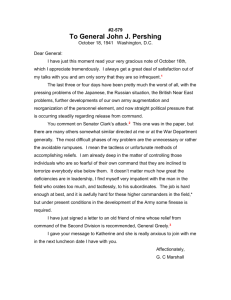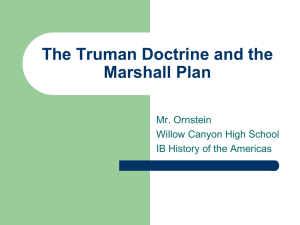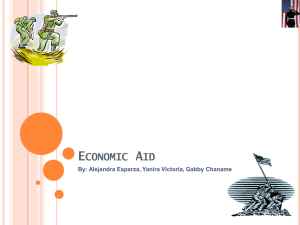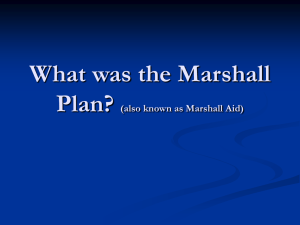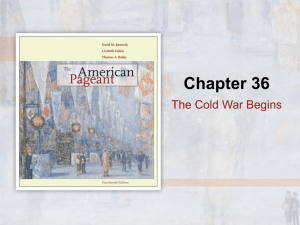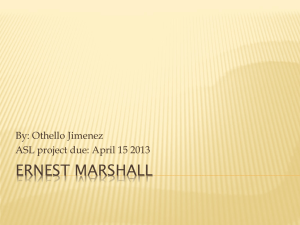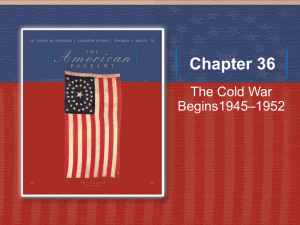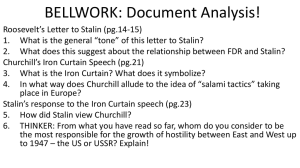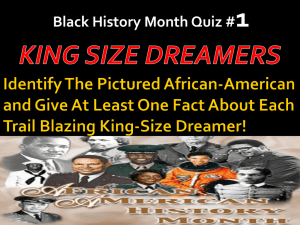The Marshall Plan and it*s Relevance to Current Policy
advertisement
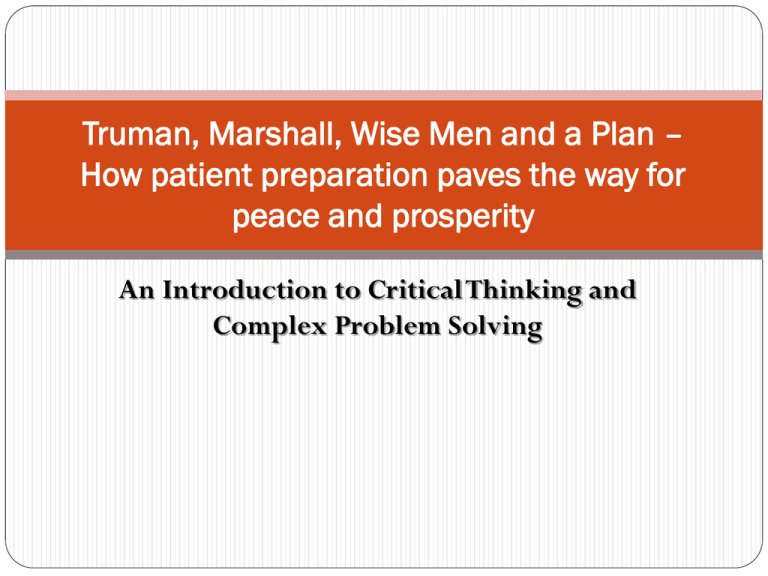
Truman, Marshall, Wise Men and a Plan – How patient preparation paves the way for peace and prosperity An Introduction to Critical Thinking and Complex Problem Solving PLANS ARE USELESS, PLANNING IS EVERYTHING Dwight D. Eisenhower 16th Chief of Staff, United States Army Levels of War Different Levels of Responsibility at Each Level National Policy Strategic Level Decisions at One Level Affect Theater Strategy Campaigns All Levels Operational Level Major Operations Truman Doctrine the “Strategic Policy” Marshall Plan the “Operational” Level Different plan applied in Asia. Battles Tactical Level Engagements Small Unit and Crew Action Why should we teach the Marshall Plan? “The true national object in war, as in peace, is a more perfect peace.” Martin Dempsey, 37th Chief of Staff, United States Army We TRAIN for certainty; we EDUCATE for uncertainty Peter Schoomaker 35th Chief of Staff, United States Army “The state that separates its scholars from its warriors will have its thinking done by cowards, and its fighting by fools.” Thucydides Marshall Plan – Answer to Question of “How to “Save” (Stabilize) Europe? Problem Solving Process Recognize and define the problem. Gather information. Develop possible solutions to the problem. Analyze possible solutions. Select the best solution. Implement the solution and assess results. Elements of National Power DIPLOMATIC ECONOMIC MILITARY INFORMATION Win/Win or Win/Lose? Potsdam: Seeking a More Perfect Peace Truman takes measure of Stalin. Was not of “one mind” on the Soviets. Against appeasement. Tried to be patient, prudent, and maintain balance. Stalin “slapped” Truman at Potsdam – Truman turned the other cheek. Offered Stalin all he knew he could take anyway – asked only one thing in return: free and unrestricted navigation of the inland waterways of Europe POWER IS NOT DIVISIBLE George C. Marshall, 15th Chief of Staff, United States Army Enduring National Interests SECURITY: The security of the United States, its citizens, and U.S. allies and partners. PROSPERITY: A strong, innovative, and growing U.S. economy in an open international economic system that promotes opportunity and prosperity. VALUES: Respect for universal values at home and around the world. INTERNATIONAL ORDER: An international order advanced by U.S. leadership that promotes peace, security, and opportunity through stronger cooperation to meet global challenges. Education of George C. Marshall US transition from Agrarian to Industrial Nation. Related to Chief Justice John Marshall. Virginia Military Institute Philippines and WW I Fort Leavenworth, KS CCC and China National Guard Aide to Chief of Staff Army Chief of Staff Complex Systems A complex system is DYNAMIC not STATIC. Composed of many parts that as a whole exhibit properties not obvious from the properties of the individual parts (The whole is greater than the sum of the parts…) Parts are intricately arranged. Examples include ant colonies, human economies and social structures, climate, nervous systems, cells and living things, including human beings, as well as modern energy or telecommunication infrastructures (i.e., networks). POLITICAL CULTURAL ECONOMIC INFRASTRUCTURE SOCIAL INFORMATIONAL Example of a Complex Problem: Choluteca “Bridge to Nowhere.” Built in 1986 Hurricane Mitch in 1998 changed the underlying environment. Simple problem of crossing the river not seen in context of a more complex, dynamic, ENVIRONMENT…. IDEA – an alternate route around the city of Choluteca, to provide new infrastructure to allow growth of commerce on the Pan American Highway – and building infrastructure to last - a good one. Marshall’s Enduring Lesson Teaches How to Solve Complex Problems – Making Good Decisions Two types of PROBLEMS PROBLEM as defined by Marshall: 1. STRUCTURED (simple) Breakdown of the business 2. UNSTRUCTURED (complex) structure of Europe. Two types of PROBLEM SOLVING: Marshall as a LEADER specifically rejected advise to cast plan as a 1. NORMATIVE (logical) blow against Communism. 2. NATURALISTIC (intuitive) Truman Doctrine and Marshall: Seeking a More Perfect Peace European Recovery: Complex Problem, conflicting Visions 1. 2. Truman gave Stalin one more chance: Win/Win vs. Win/Lose Democratic/Free Market vs. Authoritarian Centrally Planned Objective: Regional Stability Means: Public/Private Partnership Way: Collaboration and Partnership 1. 2. 3. 4. Private rather than Public Secret until 1975 No requirement to repay MILITARY loans or to return military hardware Return or lease of 40 Liberty Ships asked Good Faith effort to finance loans for Humanitarian Aid Stalin rejected – second slap. Truman Decided The Marshall Plan Most proposals for a new Marshall Plan misunderstand the INTENT of the original plan and how it worked. Plan to restore the power of Business – the private sector – as a growth engine Business, not Government or NGO, was center-piece Focus on Private Sector and Free Market intended to support shift from AID to TRADE. The Marshall Plan Four Components: Source for Funds Intensive Involvement of Private Sector 1. 2. Local Government LOANS to business Business repays Loan repayment funds commercial infrastructure Economic Policy Reforms to support PRIVATE SECTOR. 3. 4. Maker easier for ALL businesses Help new-start entrepreneurs and Mid-Size manufacturers and Large-Size enterprise to THRIVE. Plan CUT trade barriers. Regional Coordinating Body to Distribute Funds Example of a Complex Problem: Kunar Valley, Afghanistan 2006 – President bans logging and lumber sales. Wood-cutting a centuries old tradition. Deodar cedar a hard aromatic wood prized by furniture makers. A two-yard log that sells for $10 in Kunar is $150 in Karachi and $300 in Dubai. Smuggling brisk, Taliban controls and profits. Example of a Complex Problem: Kunar Valley, Afghanistan INTENT: Deny income from timber smuggling to anti-government forces (Domestic and International) Local initiative needed, but larger structure “centralized.” Marshall Plan included extensive reform to economic structures. Focus was on “rehabilitation of economic structure.” To achieve INTENT, reform at higher level is necessary. Requires initiative from the host nation. Cognition and Cognitive Processes Military or “normatic” process (logical)(left brain) Looks at PARTS, analytic, objective, sequential Mechanical/MARS Civilian or “naturalistic” process (Intuitive)(right brain) Looks at WHOLES, intuitive, subjective, parallel Biological/VENUS Critical Thinking “Critical thinking is a cognitive process that “examines assumptions, discerns hidden values, evaluates evidence, and assess conclusions. ” The intent of using cognitive skills or strategies is to increase the probability of a desirable outcome (reduce risk of failure, or the loss or waste of resources). It is used to describe thinking that is purposeful, reasoned, and goal directed.” Truman & Marshall – Military Leaders DESIGN Understanding ill-structured problems. Anticipating change Creating opportunities Recognizing and managing transitions FRAMING Frame the ENVIRONMENT – considerations include HISTORY, Culture, relationships, conflicts, Frame the PROBLEM – considerations include both friendly and adversary logic/thinking. Frame the SOLUTION – considerations include strategy, parallel and sequential activities, relationships, resources, teaching and learning mechanisms, risks, orchestration Variation on a Theme Tanzania 2008 1. 2. 3. 4. 5. Energy Scandal (Like ENRON, but in state-run utility)/Crisis in Kenya Tanzanian REFORM $700 million in Millennium Challenge Funding Investment in COMMERCIAL INFRASTRUCTURE Regional Initiative to reduce trade barriers / restrictions Variation on a Theme? DESIGN and the NEW SILK ROAD? Variation on a Theme? DESIGN and the Arab Spring? US faces a broad and COMPLEX array of challenges…, WE must now build the sources of American strength and influence, and shape an international order capable of overcoming the challenges of the 21st century. National Security Strategy The United States believes certain values are universal This include Individual’s: Freedom to speak their mind, Assemble without fear, Worship as they please, Choose their own leaders, Dignity, tolerance, and equality among all people Fair and equitable administration of justice National Security Strategy Lessons of the Marshall Plan How you make PEACE is as vital and important a decision as how you make WAR Those who PROFIT from War will directly or indirectly oppose PEACE Marshall Plan did not try to save the whole world all at once – prioritized and focused limited resources Lessons if viewed in context can be adapted and applied to other regions Lessons can be extrapolated to other aspects of RECOVERY and DEVELOPMENT Broader lesson of the Marshall Plan is not not just transition from WAR to PEACE – and seeking a more perfect peace - but how a civilized world recovers from CHAOS and restores ORDER Partnership for 21st Century Skills http://diplomacy.state.gov/exhibitions/pdf/MP_Education_Packet.pdf http://diplomacy.state.gov/exhibitions/onlineexhibitions/c23800.htm 21st Century Interdisciplinary Themes/On-Line Curriculum Aids Global awareness Financial, economic, business and entrepreneurial literacy Civic literacy Health literacy Environmental literacy The true national object in war, as in peace, is a more perfect peace. QUESTIONS?
